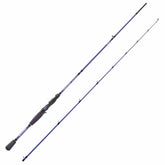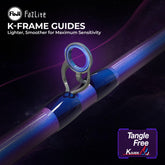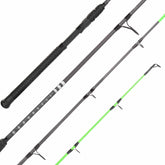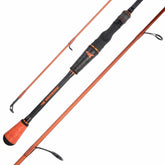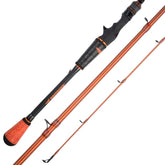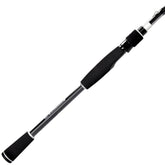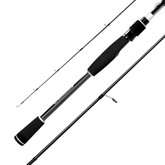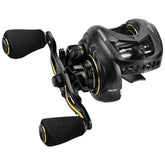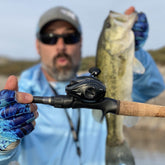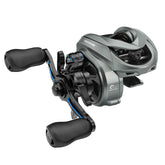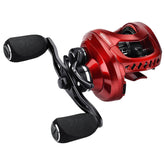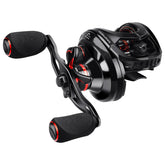-
![KastKing Royale Legend Pro Twilight Technique Bass Fishing Rods]()
![KastKing Royal Legend Pro Celestial Technique Fishing Rods]() KastKingRoyale Legend Pro Casting RodsCrafted with KastFlex IM7 graphite and Nano resins, the Royale Legend Pro delivers a lightweight, ultra-sensitive rod blank with exceptional strength and responsiveness. Line control of Royale Legend Pro Bass Fishing Rods is managed by premium Fuji Stainless Steel K Frame Guides with FazLite...
KastKingRoyale Legend Pro Casting RodsCrafted with KastFlex IM7 graphite and Nano resins, the Royale Legend Pro delivers a lightweight, ultra-sensitive rod blank with exceptional strength and responsiveness. Line control of Royale Legend Pro Bass Fishing Rods is managed by premium Fuji Stainless Steel K Frame Guides with FazLite...- Regular price
- $92.99
- Regular price
- $74.40
- Regular price
-
$92.99 - sale-discount
- -20%
- Unit price
- per
-
![KastKing Royale Legend Pro Twilight Technique Bass Fishing Rods]()
![KastKing Royale Legend Pro Celestial Technique Bass Spinning Rods]() KastKingRoyale Legend Pro Spinning RodsThe KastKing Royale Legend Pro Bass Fishing Rods use High Modulus KastFlex IM7 graphite blanks rolled under extreme pressure with Nano resins to create extremely sensitive and light rod blanks, providing unmatched strength and sensitivity. Line control of Royale Legend Pro Bass Fishing Rods...
KastKingRoyale Legend Pro Spinning RodsThe KastKing Royale Legend Pro Bass Fishing Rods use High Modulus KastFlex IM7 graphite blanks rolled under extreme pressure with Nano resins to create extremely sensitive and light rod blanks, providing unmatched strength and sensitivity. Line control of Royale Legend Pro Bass Fishing Rods...- Regular price
- $92.99
- Regular price
- $79.05
- Regular price
-
$92.99 - sale-discount
- -15%
- Unit price
- per
-
![KastKing Kestrel Fishing Rod]()
![KastKing Kestrel Fishing Rod]() KastKingKestrel Finesse Casting RodUltimate Sensitivity The KastKing Kestrel Bait Finesse System and Spin Finesse System Fishing Rods use IM8 ultra-high modulus graphite blanks rolled under extreme pressure with Nano resins to create extremely light and sensitive rod blanks, providing ultimate sensitivity for anglers. Premium Components The Kestrel...
KastKingKestrel Finesse Casting RodUltimate Sensitivity The KastKing Kestrel Bait Finesse System and Spin Finesse System Fishing Rods use IM8 ultra-high modulus graphite blanks rolled under extreme pressure with Nano resins to create extremely light and sensitive rod blanks, providing ultimate sensitivity for anglers. Premium Components The Kestrel...- Regular price
- $89.99
- Regular price
- $89.99
- Unit price
- per
-
![KastKing Kestrel Fishing Rod]()
![KastKing Kestrel Fishing Rod]() KastKingKestrel Finesse Spinning RodUltimate Sensitivity The KastKing Kestrel Bait Finesse System and Spin Finesse System Fishing Rods use IM8 ultra-high modulus graphite blanks rolled under extreme pressure with Nano resins to create extremely light and sensitive rod blanks, providing ultimate sensitivity for anglers. Premium Components The Kestrel...
KastKingKestrel Finesse Spinning RodUltimate Sensitivity The KastKing Kestrel Bait Finesse System and Spin Finesse System Fishing Rods use IM8 ultra-high modulus graphite blanks rolled under extreme pressure with Nano resins to create extremely light and sensitive rod blanks, providing ultimate sensitivity for anglers. Premium Components The Kestrel...- Regular price
- $89.99
- Regular price
- $89.99
- Unit price
- per
-
![KastKing Zephyr Finesse Spinning Rod]()
![KastKing Zephyr Finesse Spinning Rod]() KastKingZephyr Spin Finesse Extra Twin-Tip Spinning RodLightweight & Highly Sensitive Crafted with KastFlex IM6 Graphite Blanks, the KastKing Zephyr Spin Finesse fishing Rod strikes the perfect balance of lightweight performance, superior sensitivity, and enhanced durability. This advanced construction enables anglers to detect even the slightest bites, while offering precise control...
KastKingZephyr Spin Finesse Extra Twin-Tip Spinning RodLightweight & Highly Sensitive Crafted with KastFlex IM6 Graphite Blanks, the KastKing Zephyr Spin Finesse fishing Rod strikes the perfect balance of lightweight performance, superior sensitivity, and enhanced durability. This advanced construction enables anglers to detect even the slightest bites, while offering precise control...- Regular price
- $69.99
- Regular price
- $66.50
- Regular price
-
$69.99 - sale-discount
- -5%
- Unit price
- per
-
![KastKing Zephyr Finesse Casting Rod]()
![KastKing Zephyr Finesse Casting Rod]() KastKingZephyr Bait Finesse Extra Twin-Tip Casting RodLightweight & Highly Sensitive Crafted with KastFlex IM6 Graphite Blanks, the KastKing Zephyr Bait Finesse fishing Rod strikes the perfect balance of lightweight performance, superior sensitivity, and enhanced durability. This advanced construction enables anglers to detect even the slightest bites, while offering precise control...
KastKingZephyr Bait Finesse Extra Twin-Tip Casting RodLightweight & Highly Sensitive Crafted with KastFlex IM6 Graphite Blanks, the KastKing Zephyr Bait Finesse fishing Rod strikes the perfect balance of lightweight performance, superior sensitivity, and enhanced durability. This advanced construction enables anglers to detect even the slightest bites, while offering precise control...- Regular price
- $69.99
- Regular price
- $66.50
- Regular price
-
$69.99 - sale-discount
- -5%
- Unit price
- per
-
![KastKing Kong Fishing Rods]()
![KastKing Kong Fishing Rods]() KastKingKong Spinning RodsPowerful S-Curve Graphite Rod Blanks KastKing KONG series rods are designed for anglers targeting massive fish in fresh and saltwater! These lightweight, powerful, 100% graphite blanks are made of high-strength S-Curve graphite reinforced with Nano-Resin technology that delivers amazing strength and lifting power but...
KastKingKong Spinning RodsPowerful S-Curve Graphite Rod Blanks KastKing KONG series rods are designed for anglers targeting massive fish in fresh and saltwater! These lightweight, powerful, 100% graphite blanks are made of high-strength S-Curve graphite reinforced with Nano-Resin technology that delivers amazing strength and lifting power but...- Regular price
- $79.99
- Regular price
- $72.00
- Regular price
-
$79.99 - sale-discount
- -10%
- Unit price
- per
-
![KastKing Kong Fishing Rods]()
![KastKing Kong Fishing Rods]() KastKingKong Casting RodsPowerful S-Curve Graphite Rod Blanks KastKing KONG series rods are designed for anglers targeting massive fish in fresh and saltwater! These lightweight, powerful, 100% graphite blanks are made of high-strength S-Curve graphite reinforced with Nano-Resin technology that delivers amazing strength and lifting power but...
KastKingKong Casting RodsPowerful S-Curve Graphite Rod Blanks KastKing KONG series rods are designed for anglers targeting massive fish in fresh and saltwater! These lightweight, powerful, 100% graphite blanks are made of high-strength S-Curve graphite reinforced with Nano-Resin technology that delivers amazing strength and lifting power but...- Regular price
- $79.99
- Regular price
- $72.00
- Regular price
-
$79.99 - sale-discount
- -10%
- Unit price
- per
-
![KastKing Spartacus II Fishing Rods]()
![KastKing Spartacus II Fishing Rods]() KastKingSpartacus II Twin Tip Casting RodsStrong & Sensitive Construction Made from 24-ton carbon fiber and IM6 graphite blanks, this fishing rod offers unbeatable strength and sensitivity that allows you to detect even the slightest bites, increasing your chances of catching your desired species of fish. Smooth Casting Experience The...
KastKingSpartacus II Twin Tip Casting RodsStrong & Sensitive Construction Made from 24-ton carbon fiber and IM6 graphite blanks, this fishing rod offers unbeatable strength and sensitivity that allows you to detect even the slightest bites, increasing your chances of catching your desired species of fish. Smooth Casting Experience The...- Regular price
- $54.99
- Regular price
- $49.50
- Regular price
-
$54.99 - sale-discount
- -10%
- Unit price
- per
-
![KastKing Spartacus II Fishing Rods]()
![KastKing Spartacus II Fishing Rods]() KastKingSpartacus II Twin Tip Spinning RodsStrong & Sensitive Construction Made from 24-ton carbon fiber and IM6 graphite blanks, this fishing rod offers unbeatable strength and sensitivity that allows you to detect even the slightest bites, increasing your chances of catching your desired species of fish. Smooth Casting Experience The...
KastKingSpartacus II Twin Tip Spinning RodsStrong & Sensitive Construction Made from 24-ton carbon fiber and IM6 graphite blanks, this fishing rod offers unbeatable strength and sensitivity that allows you to detect even the slightest bites, increasing your chances of catching your desired species of fish. Smooth Casting Experience The...- Regular price
- $51.99
- Regular price
- $46.80
- Regular price
-
$51.99 - sale-discount
- -10%
- Unit price
- per
-
![KastKing Centron Lite Twin Tip Casting Rods]()
![KastKing Centron Lite Twin Tip Casting Rods]() KastKingCentron Lite Twin Tip Casting RodsLightweight and Sensitive IM6 Graphite Blanks KastKing Centron Lite Twin Tip Casting Rods feature a sensitive and light-weight IM6 Graphite blank, which delivers durable performance in every length. Extra Backup Tip Section The Centron Light series fishing rods includes two interchangeable tip sections with...
KastKingCentron Lite Twin Tip Casting RodsLightweight and Sensitive IM6 Graphite Blanks KastKing Centron Lite Twin Tip Casting Rods feature a sensitive and light-weight IM6 Graphite blank, which delivers durable performance in every length. Extra Backup Tip Section The Centron Light series fishing rods includes two interchangeable tip sections with...- Regular price
- $59.99
- Regular price
- $59.99
- Unit price
- per
-
![KastKing Centron Lite Twin Tip Spinning Rods]()
![KastKing Centron Lite Twin Tip Spinning Rods]() KastKingCentron Lite Twin Tip Spinning RodsLightweight and Sensitive IM6 Graphite Blanks KastKing Centron Lite Twin Tip Casting Rods feature a sensitive and light-weight IM6 Graphite blank, which delivers durable performance in every length. Extra Backup Tip Section The Centron Light series fishing rods includes two interchangeable tip sections with...
KastKingCentron Lite Twin Tip Spinning RodsLightweight and Sensitive IM6 Graphite Blanks KastKing Centron Lite Twin Tip Casting Rods feature a sensitive and light-weight IM6 Graphite blank, which delivers durable performance in every length. Extra Backup Tip Section The Centron Light series fishing rods includes two interchangeable tip sections with...- Regular price
- $49.99
- Regular price
- $45.00
- Regular price
-
$49.99 - sale-discount
- -10%
- Unit price
- per
-
![KastKing Assegai Technique Bass Fishing Rods]()
![KastKing Assegai Technique Bass Fishing Rods]() KastKingAssegai Technique Bass Fishing RodsElite Carbon Blanks & Nano Resin Technology Our new, proprietary Elite Carbon blanks deliver the ultimate in power, strength, and sensitivity with a super high,40 million modulus,750K Strain Rate graphite blank. Nano resins are forced into every Micro-Space of Assegai fishing rods through a...
KastKingAssegai Technique Bass Fishing RodsElite Carbon Blanks & Nano Resin Technology Our new, proprietary Elite Carbon blanks deliver the ultimate in power, strength, and sensitivity with a super high,40 million modulus,750K Strain Rate graphite blank. Nano resins are forced into every Micro-Space of Assegai fishing rods through a...- Regular price
- $139.99
- Regular price
- $139.99
- Unit price
- per
-
![KastKing Speed Demon Pro Tournament Series Fishing Rods]()
![KastKing Speed Demon Pro Tournament Series Fishing Rods]() KastKingOut of StockSpeed Demon Pro Tournament Series Fishing RodsElite Carbon Blanks & Nano Resin Technology Speed Demon Pro rods start with our own Elite Carbon blanks that utilize Carbon Nano Tube resin technology to reduce weight, increase breaking and lifting strength by over 30% compared to standard graphite blanks. These proprietary blanks...
KastKingOut of StockSpeed Demon Pro Tournament Series Fishing RodsElite Carbon Blanks & Nano Resin Technology Speed Demon Pro rods start with our own Elite Carbon blanks that utilize Carbon Nano Tube resin technology to reduce weight, increase breaking and lifting strength by over 30% compared to standard graphite blanks. These proprietary blanks...- Regular price
- $119.99
- Regular price
- $119.99
- Unit price
- per
-
![KastKing Zephyr Dual Tip Casting Rod]()
![KastKing Zephyr Dual Tip Casting Rod]() KastKingZephyr Dual Tip Casting RodLightweight and High-sensitivity KastKing Zephyr Dual Tip Fishing Rods are made with lightweight KastFlex IM6 Graphite material, that offer the ideal combination of power, durability, and sensitivity. Suitable for anglers of all skill levels and even experts will love these rods. Fuji O-ring Guide...
KastKingZephyr Dual Tip Casting RodLightweight and High-sensitivity KastKing Zephyr Dual Tip Fishing Rods are made with lightweight KastFlex IM6 Graphite material, that offer the ideal combination of power, durability, and sensitivity. Suitable for anglers of all skill levels and even experts will love these rods. Fuji O-ring Guide...- Regular price
- $64.99
- Regular price
- $58.50
- Regular price
-
$64.99 - sale-discount
- -10%
- Unit price
- per
-
![KastKing Zephyr Dual Tip Spinning Rod]()
![KastKing Zephyr Dual Tip Spinning Rod]() KastKingZephyr Dual Tip Spinning RodLightweight and High-sensitivity KastKing Zephyr Dual Tip Fishing Rods are made with lightweight KastFlex IM6 Graphite material, that offer the ideal combination of power, durability, and sensitivity. Suitable for anglers of all skill levels and even experts will love these rods. Fuji O-ring Guide...
KastKingZephyr Dual Tip Spinning RodLightweight and High-sensitivity KastKing Zephyr Dual Tip Fishing Rods are made with lightweight KastFlex IM6 Graphite material, that offer the ideal combination of power, durability, and sensitivity. Suitable for anglers of all skill levels and even experts will love these rods. Fuji O-ring Guide...- Regular price
- $59.99
- Regular price
- $54.00
- Regular price
-
$59.99 - sale-discount
- -10%
- Unit price
- per
-
![KastKing Verus Performance Casting Fishing Rod with Extra Tip]()
![KastKing Verus Performance Casting Fishing Rod with Extra Tip]() KastKingVerus Performance Casting Fishing Rod with Extra TipLightweight and High-sensitivity Crafted from KastFlex IM6 graphite material, the KastKing Verus performance rod with extra tip offers a perfect balance of lightness and durability. Its high sensitivity enhances bite detection, making the fishing rod an ideal choice for anglers seeking precision and control,...
KastKingVerus Performance Casting Fishing Rod with Extra TipLightweight and High-sensitivity Crafted from KastFlex IM6 graphite material, the KastKing Verus performance rod with extra tip offers a perfect balance of lightness and durability. Its high sensitivity enhances bite detection, making the fishing rod an ideal choice for anglers seeking precision and control,...- Regular price
- $74.99
- Regular price
- $67.50
- Regular price
-
$74.99 - sale-discount
- -10%
- Unit price
- per
-
![KastKing Verus Performance Spinning Fishing Rod with Extra Tip]()
![KastKing Verus Performance Spinning Fishing Rod with Extra Tip]() KastKingVerus Performance Spinning Fishing Rod with Extra TipLightweight and High-sensitivity Crafted from KastFlex IM6 graphite material, the KastKing Verus performance rod with extra tip offers a perfect balance of lightness and durability. Its high sensitivity enhances bite detection, making the fishing rod an ideal choice for anglers seeking precision and control,...
KastKingVerus Performance Spinning Fishing Rod with Extra TipLightweight and High-sensitivity Crafted from KastFlex IM6 graphite material, the KastKing Verus performance rod with extra tip offers a perfect balance of lightness and durability. Its high sensitivity enhances bite detection, making the fishing rod an ideal choice for anglers seeking precision and control,...- Regular price
- $74.99
- Regular price
- $67.50
- Regular price
-
$74.99 - sale-discount
- -10%
- Unit price
- per
-
![KastKing ReKon Saltwater Spinning Rod]()
![KastKing ReKon Saltwater Spinning Rod]() KastKingReKon Saltwater Spinning RodCrafted with a KastFlex IM6 carbon graphite blank, the KastKing ReKon Saltwater Spinning Rod is built to endure harsh saltwater conditions and deliver precise, powerful performance. Its 2-piece PTS (Power Transition System) makes it easy to transport and store, while still offering excellent sensitivity,...
KastKingReKon Saltwater Spinning RodCrafted with a KastFlex IM6 carbon graphite blank, the KastKing ReKon Saltwater Spinning Rod is built to endure harsh saltwater conditions and deliver precise, powerful performance. Its 2-piece PTS (Power Transition System) makes it easy to transport and store, while still offering excellent sensitivity,...- Regular price
- $79.99
- Regular price
- $72.00
- Regular price
-
$79.99 - sale-discount
- -10%
- Unit price
- per
-
![KastKing Perigee II Fishing Rods]()
![KastKing Perigee II Fishing Rods]() KastKingPerigee II Fishing RodsAmazing Quality Carbon Fiber Blank All Perigee II two-piece fishing rods are constructed with Toray 24-ton carbon matrix KastFlex blank technology for power, strength, and accuracy. Available in 42 sizes from an ultra light spinning fishing rod to a heavy 7’ spinning rod and...
KastKingPerigee II Fishing RodsAmazing Quality Carbon Fiber Blank All Perigee II two-piece fishing rods are constructed with Toray 24-ton carbon matrix KastFlex blank technology for power, strength, and accuracy. Available in 42 sizes from an ultra light spinning fishing rod to a heavy 7’ spinning rod and...- Regular price
- $49.99
- Regular price
- $42.50
- Regular price
-
$49.99 - sale-discount
- -15%
- Unit price
- per
KastKing have taken the art of rod building to a new level using technology and years of experience in creating rods with technique specific actions and lengths. If you’re like thousands of other anglers that want to be prepared with the perfect rod for every condition and technique, there’s a KastKing Rods that is sure to meet your needs.
The new KastKing Speed Demon Pro rods start with our industry leading, Elite Carbon blanks that utilize Carbon Nano Tube Resins to reduce weight, increase strength and provide the ultimate in sensitivity. We’ve tested every rod to ensure that the action, overall length, handle length, guide combinations and sensitivity are perfect for a given technique which will simply allow you to catch more fish with less effort, consistently.
KastKing keeps fishing fun with the best value spinning rods and baitcasting fishing rods in the fishing tackle world. Don’t let the low, super affordable price of these high end fishing rods fool you. Just like our best-selling KastKing fishing reels and line, our Perigee II two-piece rods are priced to fit your fishing gear budget. KastKing gives you affordable innovation in the new rod series!




